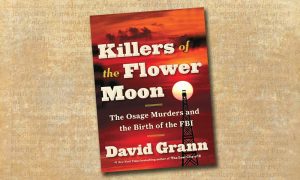I had read David Grann’s article in The New Yorker, “The Marked Woman,” last March so the outlines of this appalling story were familiar to me. The completed book, however, Killers of the Flower Moon: The Osage Murders and the Birth of the FBI (Doubleday, 2017), includes a dark coda that reminds us that all endings are arbitrary and that truth is not only elusive but illusory.
I also think that this is the kind of book that belongs in the classes on American history we require of our children. Although we, as a culture, have begun to acknowledge the genocidal intentions that underlay our duplicitous interactions with the Native Peoples we encountered from initial Columbian contact forward, those truths have been fragmentary, incomplete. It is hard to teach what is admirable about the United States of America while offering a complete portrait that includes the Founders’ feet of clay and the moral failings of our heroes.
The fact that we have sanitized our past and transformed nuanced history into straightforward propaganda also explains how we can have elected a president who describes White Supremacists as “fine people,” how we can cheer the expulsion of the Dreamers because of decisions made by their parents, how we can push for the eliminations of the Children’s Health Insurance Program (CHIP), how we can enact sweeping tax changes that put literally millions in the pockets of the superrich, explode the national debt, and threaten the very existence of a viable middle class.
What is this story? Grann focuses on Mollie (Wah-kon-tah-he-um-pah), a full-blood Osage married to a white man Ernest Burkhardt. Mollie’s parents were born on the Kansas reservation where the family of Laura Ingalls Wilder had staked a claim. (It is small details like this I find so compelling. I read all the “Little House” books as a child and I remember well the one devoted to this moment, “Little House on the Prairie,” when Wilder writes about the Osage Indians they encountered.) Expelled in 1870 when their lands became desirable to white settlers, the Osage relocated to an area in northeast Oklahoma Territory. That is where Mollie was born in 1886.
A wise chief Wah-Ti-An-Kah convinced the Osage to take this land because it was hilly, rocky, apparently worthless. “If my people go west where land is like floor of lodge,” he said, “white man will come to our lodges and say, ‘We want your land.’…Soon land will end and Osages will have no home.” It made good sense until two things happened: Oklahoma became a state 1907 and massive oil deposits were discovered in Osage land. A series of complicated actions, including forcing the Osage to turn tribal lands into allotments owned by individuals and making the rest available to settlers (the “Sooners”).
To get at the oil, prospectors had to pay for leases and royalties. That money, at first just a few dollars, turned into thousands annually and the Osage became wealthy beyond most peoples’ imaginations. The income was paid to those with “headrights”—individuals listed on the tribal rolls. This group that included Mollie, her three sisters and her parents. These shares in the mineral wealth under the ground could not be sold, only inherited. At the same time, most full-blooded Osage were denied control over their wealth; each member on the roll, and then their descendants, were assigned a “guardian,” a white man who had absolute control over what was spent, when and on what. And these guardians, unlike a trustee today, were answerable to no one and they exploited, fleeced and scammed vast sums from their charges.
It is this abusive and government-sanctioned corruption that lies at the center of the story that opens with the murder of Mollie’s sister Anna. Another sister, Minnie, had died unexpectedly of a “wasting illness” three years earlier. Then Rita, who had married Minnie’s white widower, was blown up, along with her husband and their white servant, one night. And so on.
This time became known, to the Osage, as the “Reign of Terror.”
The link between the Osage murders and the Federal Bureau of Investigation (FBI) emerges when a young J. Edgar Hoover (1895-1972) sees the chaos in this situation and determines to make it a case study for his theories of scientific investigation. He hires a lawman, Thomas White (1881-1971), charges him with organizing a team and solving the killings.
How White succeeds in finding some justice is a complicated and lengthy story—and the justice won is largely never the justice merited. The tale, however, offers a metaphor for our own times, our own perceptions of righteousness, fairness, revenge and vindication.
That coda, Chronicle Three? It will make you sick at heart.

